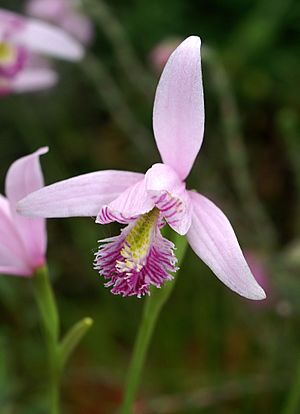Snakemouth orchid facts for kids
Quick facts for kids Snakemouth orchid |
|
|---|---|
 |
|
| Flower of Pogonia ophioglossoides | |
| Scientific classification | |
| Genus: |
Pogonia
|
| Species: |
ophioglossoides
|
| Synonyms | |
The snakemouth orchid, also known as the rose pogonia, is a beautiful wild flower. Its scientific name is Pogonia ophioglossoides. This special orchid grows across a large area. You can find it from central Canada all the way to the eastern United States. It is the main example for its group of plants, called Pogonia.
This orchid gets help from bees to make new seeds. It loves to grow in wet places. In cooler northern areas, it often lives in fens or bogs. These are types of wetlands. Further south, especially along the Gulf Coast, it prefers wet pine savannas and flatwoods.
Contents
What is the Snakemouth Orchid?
The snakemouth orchid is a type of orchid plant. Orchids are known for their unique and often colorful flowers. This particular orchid gets its common name, "snakemouth," from the shape of its flower. The lip of the flower can look a bit like a snake's open mouth. The name "rose pogonia" comes from its lovely pink or rose color.
How Big Does It Get?
This orchid is usually quite small. It typically grows to be about 10 to 40 centimeters (4 to 16 inches) tall. It has a single, narrow leaf that grows partway up its stem. Sometimes, it might have a second, smaller leaf.
What Do Its Flowers Look Like?
The snakemouth orchid usually has one to three flowers on each stem. Each flower is a pretty pink or rose color. They have a special part called a "lip" that is fringed or hairy. This lip often has yellow or white hairs. These hairs help guide bees to the flower for pollination. The flowers bloom in late spring to mid-summer.
Where Does the Snakemouth Orchid Live?
This orchid is found in many different parts of North America. Its range stretches from Newfoundland in Canada, south to Florida, and west to Texas and Minnesota in the United States.
What Kind of Habitat Does It Prefer?
The snakemouth orchid needs wet soil to grow well. It is often found in:
- Fens: These are wetlands fed by mineral-rich groundwater.
- Bogs: These are wetlands fed mostly by rainwater, often acidic.
- Wet pine savannas: These are open grasslands with scattered pine trees, common in the southern U.S.
- Flatwoods: These are flat, forested areas with sandy, poorly drained soils.
It likes open, sunny areas within these wet habitats.
How Does the Snakemouth Orchid Reproduce?
Like many plants, the snakemouth orchid reproduces using seeds. However, it needs help from insects to make these seeds.
Pollination by Bees
The snakemouth orchid is mainly pollinated by bees. When a bee visits the flower, it is attracted by the flower's color and scent. As the bee moves around the flower, pollen sticks to its body. When the bee visits another snakemouth orchid, it can transfer this pollen. This process helps the orchid create seeds.
Life Cycle of the Orchid
After successful pollination, the orchid flower develops a fruit that contains many tiny seeds. These seeds are very small and light. They can be carried by the wind to new locations. For the seeds to grow, they need a special kind of fungus in the soil. This fungus helps the tiny orchid seedling get the nutrients it needs to start growing. It can take several years for a new orchid plant to grow from a seed and become big enough to flower.
See also
 In Spanish: Pogonia ophioglossoides para niños
In Spanish: Pogonia ophioglossoides para niños

